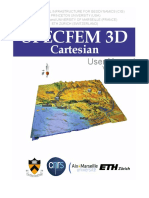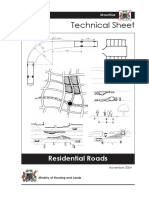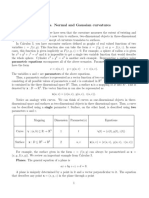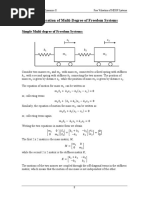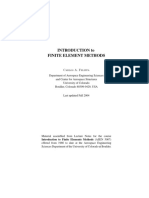Triangular Element
Uploaded by
katakgorengTriangular Element
Uploaded by
katakgorengTriangular element
Assistant Prof. Hang Thu Vu
hang@civil.uwa.edu.au
3-noded linear triangular element
3-noded linear triangular element and 6-
noded quadratic triangular element
We develop the FEM formulation for
triangular element. Linear triangular is used
for an illustration.
Element in global and local coordinate
systems
The element is mapped between the global
coordinate system and the local coordinate
system
In local coordinate system
The 2D integration does not integrate
into the element triangle area
The triangular geometry is not symmetric
about local coordinate axis. It requires a
special technique to derive the Gauss points
and Gauss weights, which involves a
triangular coordinate system
Difficult to map among three coordinate
systems
Integration in local coordinate is hence
difficult
} }
1
1
1
1
q d d
In global coordinate system
It is observed that derivatives of shape
functions in the global coordinate systems
are constants with values depending on the
nodal coordinates.
The integration is easy to evaluate
FEM formulation for the triangular elements is
the special case where formulation at
element level is preferably performed in
global coordinate system
3-noded linear triangular element
Computation at element level conducted in
global coordinates. For each element
| |
6 2 2 3 6 3
)] , ( [ ] [ ) , (
= y x N L y x B
| | | | | || | | | | || | dxdy t y x B D y x B dV y x B D y x B K
Area
T
V
T
) , ( ) , ( ) , ( ) , (
6 6
} }
= =
Node sequence
Note: When formulating at the element level, the
element nodal sequence must be in the anti-clockwise
direction for every element in the domain for the finite
element computation to work.
Trial solution
The trial solution is a linear function of form
Where unknown coefficients is to be
determined.
To be FEM trial solution, must yield nodal
solutions at three nodal points, i.e. if substituting
x and y values at each nodal point into the function,
we will have
y a x a a y x u
2 1 0
) , ( + + =
| |
=
2
1
0
1 ) , (
a
a
a
y x y x u
i
a
) , ( y x u
i
u
Compute coefficients
In matrix form
3 3 2 3 1 0
2 2 2 2 1 0
1 1 2 1 1 0
u y a x a a
u y a x a a
u y a x a a
= + +
= + +
= + +
| | } { } {
1
1
1
3
2
1
2
1
0
3 3
2 2
1 1
u a A
u
u
u
a
a
a
y x
y x
y x
=
(
(
(
Compute coefficients
Hence
is area of the linear triangular element
The element node numbering must be in
sequence to make the determinant a positive
number
| |
(
(
(
=
3
2
1
1 2 3 1 2 3
2 1 1 3 3 2
1 2 2 1 3 1 1 3 2 3 3 2
2
1
0
1
2
1
} { } {
u
u
u
x x x x x x
y y y y y y
y x y x y x y x y x y x
A
a
a
a
u A a
area
area
A
3 3
2 2
1 1
1
1
1
2
1
y x
y x
y x
A
area
=
Trial solution
Substitute found coefficient vector {a} into
function for trial solution and rearrange the
terms to describe in the form
is shape function at node i. It has a
value of 1 at node i and a value of 0 at two
other nodes. Its formula is
) , ( y x u
3 3 2 2 1 1
) , ( ) , ( ) , ( ) , ( u y x N u y x N u y x N y x u + + =
) , ( y x N
i
Shape functions
We see that the shape function is in the form
Its derivatives are
y b x b b y x N
i i i
i
) (
2
) (
1
) (
0
) , ( + + =
( ) ( ) ( ) | | y x x x y y y x y x
A
y x N
area
2 3 3 2 2 3 3 2 1
2
1
) , ( + + =
( ) ( ) ( ) | | y x x x y y y x y x
A
y x N
area
3 1 1 3 3 1 1 3 2
2
1
) , ( + + =
( ) ( ) ( ) | | y x x x y y y x y x
A
y x N
area
1 2 2 1 1 2 2 1 3
2
1
) , ( + + =
) (
1
i
i
b
x
N
=
c
c
) (
2
i
i
b
y
N
=
c
c
For each element
Matrix [B(x,y)]
| |
(
(
(
=
(
(
(
(
(
(
(
c
c
c
c
c
c
c
c
c
c
c
c
c
c
c
c
c
c
c
c
c
c
c
c
=
) 3 (
1
) 3 (
2
) 2 (
1
) 3 (
2
) 2 (
2
) 3 (
1
) 2 (
2
) 1 (
1
) 1 (
2
) 1 (
2
) 2 (
1
) 1 (
1
3 3 2
3 2
1
2 1 1
1
1 1
0
0 0
0 0
0
0
0 0
0 0
0
) , (
b b b
b b
b
b b b
b
b b
x
N
y
N
x
N
y
N
y
N
x
N
y
N
x
N
y
N
y
N
x
N
x
N
y x B
Element stiffness matrix
As terms in matrix B are constant values, the
matrix can be taken out of the integration sign.
The element stiffness matrix becomes
Next, we establish the element nodal load vector
resulted from the body load and the traction.
| | | | | | | | | | | | | | | | | | | |
area
T
Area
T
Area
T
tA B D B dA t B D B dxdy t y x B D y x B K
} }
= = = ) , ( ) , (
Nodal load vector due to body load
In 2D, the body load may be in kN/m2. The
integration is hence performed over the element
area.
If body load is constant over the element domain,
we have
{ } | |
}
=
)
`
=
Area
by
bx
by
bx
by
bx
y
x T
b
f
f
f
f
f
f
dA
q
q
y x N f
3
3
2
2
1
1
) , (
Nodal load vector due to body load
If the body load varies over the element
domain, we can use the shape functions to
interpolate between the nodal values.
It is directly given by isoparametric feature of
the element.
=
)
`
3
3
2
2
1
1
3
3
2
2
1
1
) , ( 0
0 ) , (
) , ( 0
0 ) , (
) , ( 0
0 ) , (
) , (
) , (
y
x
y
x
y
x
y
x
q
q
q
q
q
q
y x N
y x N
y x N
y x N
y x N
y x N
y x q
y x q
Nodal load vector due to body load
Hence
Gauss points and weights are not derived for
element in global coordinates. How do we do
the integration?
{ } | | | |
|
|
.
|
\
|
=
}
3
3
2
2
1
1
) , ( ) , (
y
x
y
x
y
x
Area
T
b
q
q
q
q
q
q
dA y x N y x N f
Nodal load vector due to body load
To overcome the problem with integration, we use the
element average body load multiplying with element area
and distribute equally between the nodes, i.e.
{ }
=
3
3
3
3
3
3
,
,
,
,
,
,
area ave y
area ave x
area ave y
area ave x
area ave y
area ave x
b
A q
A q
A q
A q
A q
A q
f
Nodal load vector due to traction
Next step, we consider the nodal load vector
due to load distributed on the element side
faces.
Nodal load vector due to traction
The traction distributes along the line.
We hence use one-dimensional shape
functions to interpolate the nodal values.
If the traction is constant along the element
edge
{ } | |
} }
=
)
`
=
)
`
=
s s
l
ty
tx
ty
tx
y
x
T
l
y
x T
t
f
f
f
f
ds
t
t
s N
s N
s N
s N
ds
t
t
s N f
2
2
1
1
2
2
1
1
) ( 0
0 ) (
) ( 0
0 ) (
) (
Nodal load vector due to traction
If the traction varies over the element side
face, we use the shape functions to
interpolate between the nodal values.
Having
=
)
`
2
2
1
1
2
2
1
1
) ( 0
0 ) (
) ( 0
0 ) (
) (
) (
y
x
y
x
y
x
t
t
t
t
s N
s N
s N
s N
s t
s t
Nodal load vector due to traction
Substitute the isoparametric expression and
multiply out the terms, the nodal load vector
due to traction becomes
{ } | | | |
(
(
(
(
(
(
(
(
|
|
.
|
\
|
=
}
2
2
1
1
2
2
1
1
3
0
6
0
0
3
0
6
6
0
3
0
0
6
0
3
) ( ) (
y
x
y
x
s s
s s
s s
s s
y
x
y
x
l
T
t
t
t
t
t
l l
l l
l l
l l
t
t
t
t
ds s N s N f
s
Compute matrix terms
I compute one entry of matrix
for illustration.
All other matrix entries are computed in a
similar manner.
Consider the entry located at column 1 and
row 1 intersection.
| | | |
|
|
.
|
\
|
}
s
l
T
ds s N s N ) ( ) (
| | | | | | | |
} }
=
1
1
1 1 1 1
) ( ) ( ) ( ) ( d J N N ds s N s N
T
l
T
s
Compute matrix terms
Where
Substitute these terms in the integral, we
have
2
1
) (
1
= N
2 2
1 2 s
l s s
J =
=
| | | |
3 3
1
4
1
2 2
1
2
) ( ) (
1
1
2 3
1
1
2
1 1
s s
l
s
T
l l
d
l
ds s N s N
s
=
|
.
|
\
|
+ =
|
.
|
\
|
=
} }
You might also like
- (Mamoru Hosaka (Auth.) ) Modeling of Curves and SuNo ratings yet(Mamoru Hosaka (Auth.) ) Modeling of Curves and Su363 pages
- Shyfem Finite Element Model For Coastal Seas User ManualNo ratings yetShyfem Finite Element Model For Coastal Seas User Manual54 pages
- Geometric Diffusions As A Tool For Harmonic Analysis and Structure Definition of Data: Diffusion MapsNo ratings yetGeometric Diffusions As A Tool For Harmonic Analysis and Structure Definition of Data: Diffusion Maps6 pages
- A Novel 3D Skeleton Algorithm Based On Neutrosophic Cost FunctionNo ratings yetA Novel 3D Skeleton Algorithm Based On Neutrosophic Cost Function8 pages
- Unwritten Procedural Modeling With The Straight SkeletonNo ratings yetUnwritten Procedural Modeling With The Straight Skeleton257 pages
- Li Supervised Fitting of Geometric Primitives To 3D Point CloudsNo ratings yetLi Supervised Fitting of Geometric Primitives To 3D Point Clouds9 pages
- (Symbolic & Numeric Computation) Mikhail Shashkov - Conservative Finite-Difference Methods On General Grids-CRC Press (1995)No ratings yet(Symbolic & Numeric Computation) Mikhail Shashkov - Conservative Finite-Difference Methods On General Grids-CRC Press (1995)379 pages
- Modern Applications of Graph Theory 1st Edition Zverovich all chapter instant download100% (1)Modern Applications of Graph Theory 1st Edition Zverovich all chapter instant download50 pages
- MeshNet - Mesh Neural Network For 3D Shape RepresentationNo ratings yetMeshNet - Mesh Neural Network For 3D Shape Representation9 pages
- A154107982 - 15745 - 11 - 2019 - Fuzzy LogicNo ratings yetA154107982 - 15745 - 11 - 2019 - Fuzzy Logic90 pages
- Shakibajahromi RIMeshGNN A Rotation-Invariant Graph Neural Network For Mesh Classification WACV 2024 PaperNo ratings yetShakibajahromi RIMeshGNN A Rotation-Invariant Graph Neural Network For Mesh Classification WACV 2024 Paper11 pages
- Hex - Mesh - Generation - and - Processing - A - SurveyNo ratings yetHex - Mesh - Generation - and - Processing - A - Survey44 pages
- LN3Diff: Scalable Latent Neural Fields Diffusion For Speedy 3D GenerationNo ratings yetLN3Diff: Scalable Latent Neural Fields Diffusion For Speedy 3D Generation29 pages
- Numerical Grid Generation Foundations AnNo ratings yetNumerical Grid Generation Foundations An1 page
- Contour Detection and Hierarchical Image SegmentationNo ratings yetContour Detection and Hierarchical Image Segmentation19 pages
- 2016 Book AdvancesInDiscreteDifferentialNo ratings yet2016 Book AdvancesInDiscreteDifferential441 pages
- Spectral Mesh Processing: SIGGRAPH Asia 2009 Course 32No ratings yetSpectral Mesh Processing: SIGGRAPH Asia 2009 Course 3247 pages
- Higher Order 2D Solid Elements. Shape Functions andNo ratings yetHigher Order 2D Solid Elements. Shape Functions and29 pages
- On Teaching Finite Element Method in Plasticity With MathematicaNo ratings yetOn Teaching Finite Element Method in Plasticity With Mathematica10 pages
- Introduction To Finite Element Method PDFNo ratings yetIntroduction To Finite Element Method PDF13 pages
- Parametric Models of Facade Designs of High-Rise Residential BuildingsNo ratings yetParametric Models of Facade Designs of High-Rise Residential Buildings8 pages
- Direction Cosines and Direction Ratios - YT - DoneNo ratings yetDirection Cosines and Direction Ratios - YT - Done17 pages
- Static Analysis of Timoshenko Beams Using Isogeometric ApproachNo ratings yetStatic Analysis of Timoshenko Beams Using Isogeometric Approach9 pages
- Introduction To Finite Element Methods: Dr. Kiran M. CNo ratings yetIntroduction To Finite Element Methods: Dr. Kiran M. C47 pages
- FEM1D - NONLINEAR - Finite Element Method For 1D Nonlinear ProblemNo ratings yetFEM1D - NONLINEAR - Finite Element Method For 1D Nonlinear Problem3 pages
- The Second Fundamental Form. Geodesics. The Curvature Tensor. The Fundamental Theorem of Surfaces. ManifoldsNo ratings yetThe Second Fundamental Form. Geodesics. The Curvature Tensor. The Fundamental Theorem of Surfaces. Manifolds24 pages
- Queueing Networks and Markov Chains: Modeling and Performance Evaluation with Computer Science ApplicationsFrom EverandQueueing Networks and Markov Chains: Modeling and Performance Evaluation with Computer Science Applications5/5 (1)
- Linear Programming With Matlab: Z 150x 175x 150x 175xNo ratings yetLinear Programming With Matlab: Z 150x 175x 150x 175x6 pages
- Example II Matrix Chain Multiplication ProblemNo ratings yetExample II Matrix Chain Multiplication Problem14 pages
- Lab 2 Linear Algebra For It - 501032: 1 ExercisesNo ratings yetLab 2 Linear Algebra For It - 501032: 1 Exercises2 pages
- Modules and The Structure of Rings: A Primer100% (1)Modules and The Structure of Rings: A Primer218 pages
- Study Material Mathematics Class Xii 2022 - 2023 Ziet Mysore100% (1)Study Material Mathematics Class Xii 2022 - 2023 Ziet Mysore74 pages
- Patna University: Courses of Study For M.A./M.Sc. (STATISICS)No ratings yetPatna University: Courses of Study For M.A./M.Sc. (STATISICS)24 pages
- 1.1 Position, Distance, and DisplacementNo ratings yet1.1 Position, Distance, and Displacement5 pages
- Quaternionic Operator Calculus For Boundary Value Problems of Micropolar ElasticityNo ratings yetQuaternionic Operator Calculus For Boundary Value Problems of Micropolar Elasticity13 pages
- Introduction To Tensors: Contravariant and Covariant VectorsNo ratings yetIntroduction To Tensors: Contravariant and Covariant Vectors18 pages
- Matrix Mathematics Theory Facts and Formulas Second Edition Dennis S. Bernstein all chapter instant download100% (12)Matrix Mathematics Theory Facts and Formulas Second Edition Dennis S. Bernstein all chapter instant download50 pages
- (Mamoru Hosaka (Auth.) ) Modeling of Curves and Su(Mamoru Hosaka (Auth.) ) Modeling of Curves and Su
- Shyfem Finite Element Model For Coastal Seas User ManualShyfem Finite Element Model For Coastal Seas User Manual
- Geometric Diffusions As A Tool For Harmonic Analysis and Structure Definition of Data: Diffusion MapsGeometric Diffusions As A Tool For Harmonic Analysis and Structure Definition of Data: Diffusion Maps
- A Novel 3D Skeleton Algorithm Based On Neutrosophic Cost FunctionA Novel 3D Skeleton Algorithm Based On Neutrosophic Cost Function
- Unwritten Procedural Modeling With The Straight SkeletonUnwritten Procedural Modeling With The Straight Skeleton
- Li Supervised Fitting of Geometric Primitives To 3D Point CloudsLi Supervised Fitting of Geometric Primitives To 3D Point Clouds
- (Symbolic & Numeric Computation) Mikhail Shashkov - Conservative Finite-Difference Methods On General Grids-CRC Press (1995)(Symbolic & Numeric Computation) Mikhail Shashkov - Conservative Finite-Difference Methods On General Grids-CRC Press (1995)
- Modern Applications of Graph Theory 1st Edition Zverovich all chapter instant downloadModern Applications of Graph Theory 1st Edition Zverovich all chapter instant download
- MeshNet - Mesh Neural Network For 3D Shape RepresentationMeshNet - Mesh Neural Network For 3D Shape Representation
- Shakibajahromi RIMeshGNN A Rotation-Invariant Graph Neural Network For Mesh Classification WACV 2024 PaperShakibajahromi RIMeshGNN A Rotation-Invariant Graph Neural Network For Mesh Classification WACV 2024 Paper
- Hex - Mesh - Generation - and - Processing - A - SurveyHex - Mesh - Generation - and - Processing - A - Survey
- LN3Diff: Scalable Latent Neural Fields Diffusion For Speedy 3D GenerationLN3Diff: Scalable Latent Neural Fields Diffusion For Speedy 3D Generation
- Contour Detection and Hierarchical Image SegmentationContour Detection and Hierarchical Image Segmentation
- Spectral Mesh Processing: SIGGRAPH Asia 2009 Course 32Spectral Mesh Processing: SIGGRAPH Asia 2009 Course 32
- Higher Order 2D Solid Elements. Shape Functions andHigher Order 2D Solid Elements. Shape Functions and
- On Teaching Finite Element Method in Plasticity With MathematicaOn Teaching Finite Element Method in Plasticity With Mathematica
- Parametric Models of Facade Designs of High-Rise Residential BuildingsParametric Models of Facade Designs of High-Rise Residential Buildings
- Direction Cosines and Direction Ratios - YT - DoneDirection Cosines and Direction Ratios - YT - Done
- Static Analysis of Timoshenko Beams Using Isogeometric ApproachStatic Analysis of Timoshenko Beams Using Isogeometric Approach
- Introduction To Finite Element Methods: Dr. Kiran M. CIntroduction To Finite Element Methods: Dr. Kiran M. C
- FEM1D - NONLINEAR - Finite Element Method For 1D Nonlinear ProblemFEM1D - NONLINEAR - Finite Element Method For 1D Nonlinear Problem
- The Second Fundamental Form. Geodesics. The Curvature Tensor. The Fundamental Theorem of Surfaces. ManifoldsThe Second Fundamental Form. Geodesics. The Curvature Tensor. The Fundamental Theorem of Surfaces. Manifolds
- Queueing Networks and Markov Chains: Modeling and Performance Evaluation with Computer Science ApplicationsFrom EverandQueueing Networks and Markov Chains: Modeling and Performance Evaluation with Computer Science Applications
- Linear Programming With Matlab: Z 150x 175x 150x 175xLinear Programming With Matlab: Z 150x 175x 150x 175x
- Study Material Mathematics Class Xii 2022 - 2023 Ziet MysoreStudy Material Mathematics Class Xii 2022 - 2023 Ziet Mysore
- Patna University: Courses of Study For M.A./M.Sc. (STATISICS)Patna University: Courses of Study For M.A./M.Sc. (STATISICS)
- Quaternionic Operator Calculus For Boundary Value Problems of Micropolar ElasticityQuaternionic Operator Calculus For Boundary Value Problems of Micropolar Elasticity
- Introduction To Tensors: Contravariant and Covariant VectorsIntroduction To Tensors: Contravariant and Covariant Vectors
- Matrix Mathematics Theory Facts and Formulas Second Edition Dennis S. Bernstein all chapter instant downloadMatrix Mathematics Theory Facts and Formulas Second Edition Dennis S. Bernstein all chapter instant download




